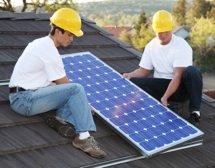Residential Solar Power
Establishing a home solar power system.
Residential Solar Power guide. What you need to know before you buy a home solar power system and economical ways to incorporate solar for your home and outdoor space.
Develop a home solar power systems that fits your needs and your budget.
Residential solar power systems can either be tied to your existing power grid (grid tied) or completely independent of conventional modes of energy (off grid).

A solar grid tie system has certain advantages to urban and suburban homeowners who want solar power but not the substantial costs associated with an off grid residential solar system.
Off grid power systems, on the other hand, are often the only choice for more remote areas and for those who want total energy independence. Once an off grid, home solar power system has been established in a sunny area it will continue to function for as many as 40 years, with very little maintenance, even on a remote island.
In any case there are many different ways of using solar energy and photovoltaic systems should be added after less expensive methods have been exhausted. Photovoltaics are the solar panels that actually produce electricity. A photovoltaic system is the most expensive type of solar energy on the market.
Many of your home's needs can be met with low technology and less expensive forms of solar energy. Don't start purchasing your residential solar power system until you have reduced your energy needs as much as possible by conserving energy, applying passive solar concepts wherever possible and replacing water heaters and pumps with solar varieties.
Not every power company offers the option of tying your system into the grid. Check with local authorities to find more specific information on this option.
Also, many government and energy authorities offer incentives in the form of tax cuts, subsidies and rebates. US residents can check here for information on residential solar power incentives in your area.
Before you get in the car and head out to the solar power store there are several things that you can do to keep the cost of your system down to earth.
For Grid Tie and Off Grid Residential Solar Power
Want to reduce the size of the home solar power system you will require? Implementing the following tips can reduce the amount of energy you need by more than half.
Reduce your current energy use.
Save money and live a little greener, even if you don't use solar power. Here are some great energy conservation tips.Employ passive solar energy
Many of our passive solar energy concepts can be applied to your home for free. Passive design takes advantage of the heat and light offered by the sun to reduce your energy consumption. Why pay for it when you can have it for free?Install a solar water heater
Solar water heaters are a low tech home solar power system that is much less expensive than pv solar panels. Also great for heating swimming pools.Use Solar Outdoor Lighting
Reduce your outdoor lighting energy demand by switching to solar lighting options.Switch to Solar Water Pumps
Solar Powered Water Pumps are much more efficient than AC pumps and if you intend to use solar energy, water pumps are a good place to begin.Find a sunny location
Any residential solar power system depends on sunlight for making energy. Choose a sunny south or southwest facing (north or northwest in southern latitudes) location where unrestricted sunlight falls for several hours per day. Make sure the location will not be shaded during the sunniest part of the day by trees, buildings or landscape features. A roof is often the best area for the solar array but the ground also works well or a specially constructed platform can be used.Sufficient angle
Angle your solar panels at an angle that equals your latitude (48 degree latitude, 48 degree angle from the ground) plus or minus 15 degrees depending on the time of year (15 degrees less in the summer and 15 degrees more in the winter). Many homeowners choose the angle that best suits their purposes and mount them at that angle permanently. Trackers are an option that automatically track the sun at the best angle.Roofing Considerations.
A residential solar system will function for as many as 40 years. It's best to apply your solar system to a roof that's less than 7 years old. It is not cost effective to install your residential solar array on a roof that will need replacement during the life of the system.Expected Life.
In the beginning, a residential solar power system was thought to last about 25 years, but recent studies have noted that solar powered systems that were installed in the mid 70's are still producing power and showing no inclination to stop. It is now thought that a home solar power system will function for 40+ years.
If you're building a new house you're in a great position to make some decisions now that will reduce the home's energy needs throughout it's life. By orienting your home and roof at the best angle and incorporating passive solar concepts into your home design you can dramatically reduce the cost of a residential solar power system.
Visitors to our Residental Solar Power page may also be interested in these pages
Solar Power for Homes
Off Grid Solar Power
Solar Grid Tie System






